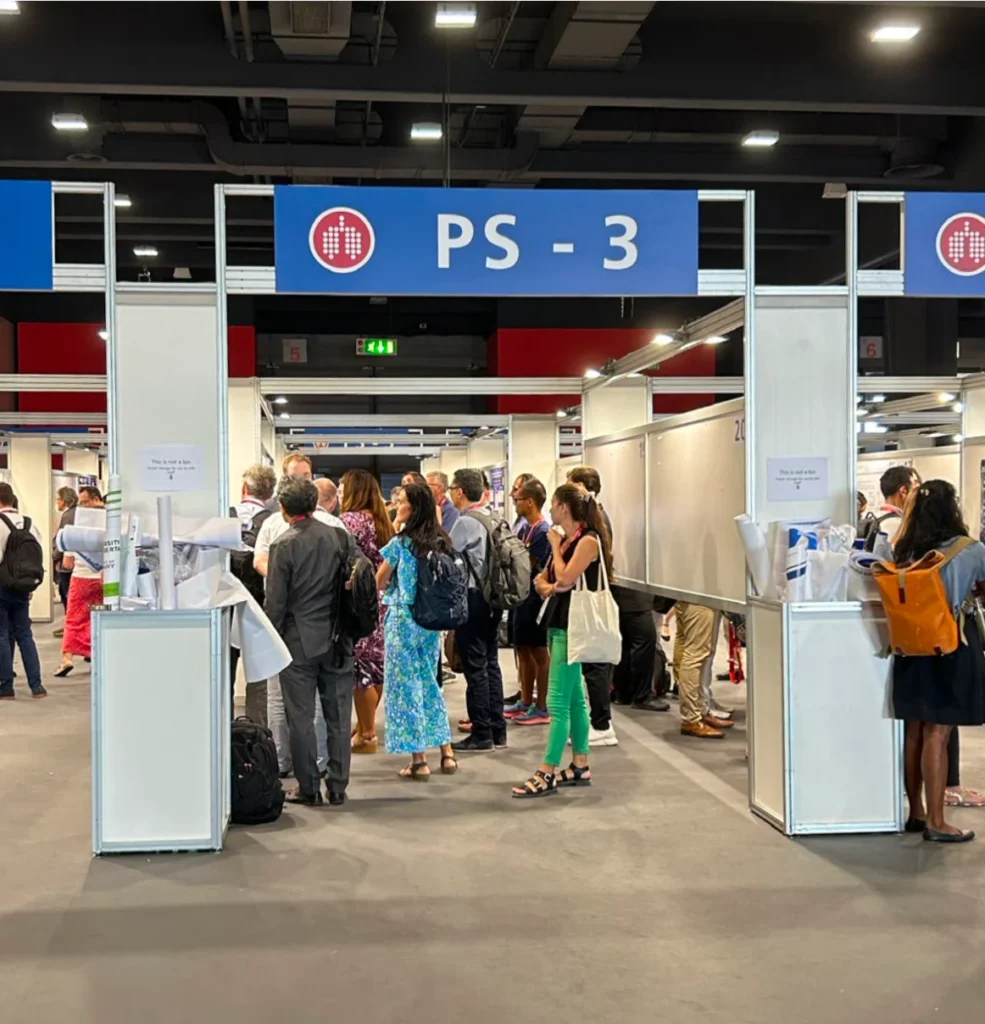Due to the nature of longitudinal studies, the data and learnings obtained are as plenty as they are important and relevant. This became very clear when attending the session covering four longitudinal studies from the field of asthma and COPD. During the discussions, it was also underlined that no trivial baseline characterization of cohorts in clinical trials can be allowed in future to be able to see the full picture.
U-BIOPRED cohort
Kian Fan Chung (London, UK) shared insights from the U-BIOPRED cohort, investigating Unbiased Biomarkers for the Prediction of Respiratory Disease Outcomes.
Here, system biology was applied to reveal mechanisms of severe asthma. This resulted in the definition of several clusters, each comprising a distinct phenotype of the disease. One of the discovered clusters of biomarkers include the combination of blood eosinophils and fraction of exhaled nitric oxide, FeNO to be able to detect the IL-13 Type2 hi phenotype1. Other clusters of biomarker combination define phenotypes of disease including “T2 low/non-T2”, which can either involve inflammasomes, Interferons and tumor-necrosis factor, or show signs of oxidative stress and aging, while being paucigranulocytic.
Moreover, the role of mast cells in asthma was confirmed, and the importance of distinguished activation2 pathways, i.e. via IgE-receptor activation or Interleukin-33-receptor activation. Results from the U-BIOPRED cohort also identified interleukin-6 as a potentially important pharmaceutical target for a cluster of “IL-6 Transsignalling high” severe asthmatics3.
Read more about the study and its results on the homepage of the Innovative Medicine Initiative,
https://www.imi.europa.eu/projects-results/project-factsheets/u-biopred).
COPDGene study
The COPDGene study was presented by MeiLan Han (Ann Arbor, USA). Initially set-up to investigate underlying genetic factors of COPD, this study currently collects data from the 15 year follow-up. Although this cohort of n=5564 subjects identified a list of genetic loci associated with COPD4 (Hobbs Nat Gen 2017), it is still a mystery how these genes influence COPD genesis, Dr. Han says. The impact of genes appears rather small and is only detectable if genes are combined. The cohort also found a group of subjects not fulfilling the diagnostic criteria of COPD, which nevertheless have symptoms, exacerbations and radiographic abnormalities5. Dr. Han refers to the “myth of the healthy smoker”.
The COPDGene cohort also collected data on the causes of deaths occurring and found that these differ between different GOLD stages. Milder disease leads to death by cardiovascular causes and lung cancer, while patients in GOLD 3 and 4 decease in respiratory failure.
Finding from the cohort actually led to changes in routines at in Michigan, USA: from CT scans, a PA:A enlargement is an indicator for increased risk of exacerbations and is now included in the CT report. Moreover, small airways disease is identified as a precursor for emphysema and now reported if present on CT scans.
ATLANTIS
The ATLANTIS6 study, aiming to assess the involvement of small airways in asthma, presented by Monika Kraft (NY, USA), collected data from mild to moderate asthmatics for 8 years. Already in 1996, Dr. Kraft demonstrated that inflammation exists throughout the whole branch of the lungs. The study shows that the distal lung can no longer be referred to as the silent zone. ATLANTIS was the first study to collect data in a bigger sample size (n=773 individuals). Over 90% of study subjects were shown to have at least one sign of small airway dysfunction amongst all different measures performed7. Physiological, but not CT measurements, are drivers for exacerbations, and oscillometry measurements are of value8. The ATLANTIS investigators hope to develop a single question-tool to be provided to clinicians that would allow identification of small airways dysfunction and with this, identifying who is at risk of exacerbations. Moreover, data from persons living with COPD is required.
NOVELTY
A study cohort collecting real world evidence from asthma, COPD or combination of both, Alberto Papi (Cona, Ferrara, Italy) presented the 3 year long NOVELTY study9. The study starts from real life and physician’s diagnosis of disease, to thereafter break down the learnings into disease mechanisms10 and treatable traits.11 They are now starting to dig deeper into the molecular and underlying pathways and are hoping to present more insights characterizing new clinical endotypes within asthma and/or COPD. It will be exciting to see the future results of the study.

Barbara Fuchs
Medical Manager, Chiesi Nordics


References
- Pavlidis S, Takahashi K, Ng Kee Kwong F, et al. ”T2-high” in severe asthma related to blood eosinophil, exhaled nitric oxide and serum periostin. Eur Respir J. 2019;53(1):1800938. Published 2019 Jan 3. doi:10.1183/13993003.00938-2018
- Tiotiu A, Badi Y, Kermani NZ, et al. Association of Differential Mast Cell Activation with Granulocytic Inflammation in Severe Asthma. Am J Respir Crit Care Med. 2022;205(4):397-411. doi:10.1164/rccm.202102-0355OC
- Jevnikar Z, Östling J, Ax E, et al. Epithelial IL-6 trans-signaling defines a new asthma phenotype with increased airway inflammation. J Allergy Clin Immunol. 2019;143(2):577-590. doi:10.1016/j.jaci.2018.05.026
- Hobbs BD, de Jong K, Lamontagne M, et al. Genetic loci associated with chronic obstructive pulmonary disease overlap with loci for lung function and pulmonary fibrosis. Nat Genet. 2017;49(3):426-432. doi:10.1038/ng.3752
- Regan EA, Lynch DA, Curran-Everett D, et al. Clinical and Radiologic Disease in Smokers With Normal Spirometry [published correction appears in JAMA Intern Med. 2015 Sep;175(9):1588]. JAMA Intern Med. 2015;175(9):1539-1549. doi:10.1001/jamainternmed.2015.2735
- Postma DS, Brightling C, Fabbri L, van der Molen T, Nicolini G, Papi A, Rabe KF, Siddiqui S, Singh D, van den Berge M, Kraft M. Unmet needs for the assessment of small airways dysfunction in asthma: introduction to the ATLANTIS study. Eur Respir J. 2015 Jun;45(6):1534-8. doi: 10.1183/09031936.00214314. PMID: 26028618.
- Postma DS, Brightling C, Baldi S, Van den Berge M, Fabbri LM, Gagnatelli A, Papi A, Van der Molen T, Rabe KF, Siddiqui S, Singh D, Nicolini G, Kraft M; ATLANTIS study group. Exploring the relevance and extent of small airways dysfunction in asthma (ATLANTIS): baseline data from a prospective cohort study. Lancet Respir Med. 2019 May;7(5):402-416. doi: 10.1016/S2213-2600(19)30049-9. Epub 2019 Mar 12. Erratum in: Lancet Respir Med. 2019 Sep;7(9):e28. PMID: 30876830.
- Kraft M, Richardson M, Hallmark B, Billheimer D, Van den Berge M, Fabbri LM, Van der Molen T, Nicolini G, Papi A, Rabe KF, Singh D, Brightling C, Siddiqui S; ATLANTIS study group. The role of small airway dysfunction in asthma control and exacerbations: a longitudinal, observational analysis using data from the ATLANTIS study. Lancet Respir Med. 2022 Jul;10(7):661-668. doi: 10.1016/S2213- 2600(21)00536-1. Epub 2022 Mar 2. PMID: 35247313.
- Golam SM, Janson C, Beasley R, FitzGerald JM, Harrison T, Chipps B, Hughes R, Müllerová H, Olaguibel JM, Raps- omaniki E, Reddel HK, Sadatsafavi M; NOVELTY study investigators. The burden of mild asthma: Clinical burden and healthcare resource utilisation in the NOVELTY study. Respir Med. 2022 Aug-Sep;200:106863. doi: 10.1016/j. rmed.2022.106863. Epub 2022 May 9. PMID: 35952579.
- Hughes R, Rapsomaniki E, Bansal AT, Vestbo J, Price D, Agustí A, Beasley R, Fageras M, Alacqua M, Papi A, Müllerová H, Reddel HK; NOVELTY Scientific Community; NOVELTY study investigators. Cluster Analyses From the Real-World NOVELTY Study: Six Clusters Across the Ast- hma-COPD Spectrum. J Allergy Clin Immunol Pract. 2023 Sep;11(9):2803-2811. doi: 10.1016/j.jaip.2023.05.013. Epub 2023 May 23. PMID: 37230383.
- Agustí A, Rapsomaniki E, Beasley R, Hughes R, Müllerová H, Papi A, Pavord ID, van den Berge M, Faner R; NOVELTY Study Investigators. Treatable traits in the NOVELTY study. Respirology. 2022 Nov;27(11):929-940. doi: 10.1111/ resp.14325. Epub 2022 Jul 21. Erratum in: Respirology. 2022 Dec;27(12):1095. PMID: 35861464; PMCID: PMC9795904.
ID 345-2023-MARK (Sept 2023)